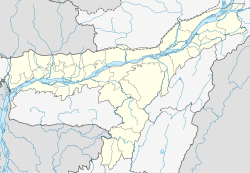Shikdamakha
Shikdamakha | |
|---|---|
Village | |
 Shikdamakha Village | |
| Coordinates: 25°56′55″N 92°13′25″E / 25.9487°N 92.2237°E | |
| Country | India |
| State | Assam |
| Region | Hamren |
| District | West Karbi Anglong district |
| Languages | |
| • Official | English and Assamese |
| • Spoken | Tiwa, Karbi, Khasi, English and Hindi |
| Time zone | UTC+5:30 (IST) |
| PIN | 782413 |

Shikdamakha (Tiwa village) is a village in the West Karbi Anglong district of Assam state [1][2] in North East India. It falls under the Amri development block and Vidhan Sabha No.20 Baithalangso ST LAC.[3]
Geography
Shikdamakha is at 25.9487°N 92.2237°E. It lies in the center of the Umswai Valley and is surrounded by hills, two of which are revered in Tiwa tradition: Palakhongor and Shabri Makha. The village is 80 km (50 mi) from the state capital Dispur-Guwahati[4] which can be accessed by road along National Highway 37 (India), a journey of about 2 hours 30 minutes through lush green hills.
Demographics
As per 2011 Population Census report, Shikdamakha is a home to 103 households.[5] Shikdamakha has a population of 595 of which 321 are males and 274 are females. Inhabited by mainly Tiwa tribe people. The people of Shikdamakha are humble and hardworking and 75.15% are literate. It is a Christian dominated village.
Places of interest
- Palakhongor:A tourists destination, 6 km (3.7 mi) from the village. It offers a panoramic view of the scenic Umswai Valley.
- Tiwa Monolith:On the top of a small hill in Amsai Pinung (One of the Tiwa root village) 2 km (1.2 mi) away from Shikdamakha, there is a spot that contains more than 2000 rock monoliths. Each of these monoliths is a set of two stone slabs-one base and one body. The Tiwas plant one set every year to honor their ancestors.
- Orchid garden:Visit the Orchid Garden which is just behind the Stadium and admire exceptional orchids that grow around and on trees with their long aerial roots.
- Don Bosco Higher Secondary School,Umswai
- Mary Mother of God Church,Umswai
Etymology
The word Shikdamakha in Tiwa language means 'hillocks of traps'. The local folklore suggests that ghost used to trap humans.[5]

Sanitation
On 25 September 2016, the Government of Assam and the Public Health Engineering Department (PHED) named Shikdamakha the cleanliness village in the state.[6] On 15 October 2016 the Karbi Anglong Autonomous Council (KAAC) declared Shikdamakha as the cleanest village of West Karbi Anglong District.[6] Villagers use bamboo baskets for storing garbage in front of every household and every corner of the village, and the accumulated garbage is disposed at a regular intervals. Thrice in a week men and women take part in a community cleaning drive.[5]
References
- ^ "Chidamakha, AMRI, WEST KARBI ANGLONG, ASSAM - Hindustan Search". www.hindustansearch.com. Retrieved 2021-07-29.
- ^ "Shikdamakha". www.wikidata.org. Retrieved 2021-08-05.
- ^ "Umswai Catholic Centre - Chintamakha". wikimapia.org. Retrieved 2021-07-29.
- ^ "Assam Hamlet Wishes To Become 'Cleanest Village In Asia' | News". NDTV-Dettol Banega Swasth Swachh India. 2017-02-14. Retrieved 2021-07-29.
- ^ a b c Gani, Abdul (2 February 2017). "Way before Swacch Bharat, a remote Assam village had set cleanliness goals for itself". Scroll.in. Retrieved 2021-07-27.
- ^ a b "west karbi anglong: West Karbi Anglong village to get Open Defecation-Free status today | Guwahati News - Times of India". The Times of India. TNN. Jan 25, 2017. Retrieved 2021-07-29.
External links


